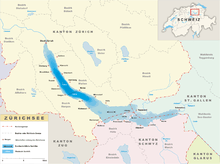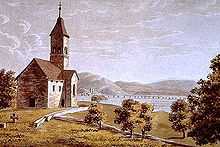Ufenau
| Native name: Ufnau | |
|---|---|
 Aerial view | |
 | |
| Geography | |
| Location | Lake Zürich |
| Highest elevation | 423 m (1,388 ft) |
| Country | |
|
Switzerland | |
| Canton | Schwyz |
| District | Höfe |
Ufenau is an island located, with the neighbouring island of Lützelau, in Lake Zürich in Switzerland between Freienbach (0.9 km away) and Rapperswil (2.5 km away).
Geography

Ufenau lies in Höfe district in the Canton of Schwyz. The island measures 112,645 m² in all, 470 m from east to west and 220 m from north to south. The highest point of the island is 423 m above sea level or 17 m above lake level (406 m). Ufnau – correctly spelled «Ufnau», but «Ufenau» is commonly used – and the Frauenwinkel area were placed under conservation in 1927. Swimming, camping and other leisure activities are forbidden, as it is a protected area. The island has a restaurant called «Zu den zwei Raben», built in 1870. Tourist boat trips, run by the Zürichsee-Schifffahrtsgesellschaft, sail from Zürich and Rapperswil.
History and touristic highlights
Highlights on Ufenau include St. Peter & Paul church, St. Martin's chapel, and Ufenau's idyllic landscape. In 1st and 2nd century, the remains of a roman temple are dated, broken during Alamannic occupation of the Swiss plateau. In 5th or 6th century, a first Christian church was built on this probably pre-Roman sacred area.
Ufenau is first mentioned in 741 as «Hupinauia», and in 744 as «Ubinauvia» – island of Huppan or Huphan. Probably between 900 and 920, the early Christian church was destroyed by the Huns. On January 23, 965, the island was given by Emperor Otto I to Einsiedeln Abbey, that still is its owner. In 926 or some years later, St. Peter & Paul church' preceding building was given by the Hunfridings noblewoman Reginlinda and Burchard II, Duke of Swabia, in addition with a house for herself and her son Adalrich. Reginlinda died in 958 and is buried in Einsiedeln. In 973, later Saint Adalrich (Canonization in 1659) died on Ufenau.
_-_Innenansicht_2011-07-25_17-46-48_ShiftN.jpg)

_2011-07-25_16-52-02.jpg)

_-_Innenansicht_2011-07-25_16-55-52.JPG)
_2011-07-25_17-11-00.JPG)
Today's St. Peter & Paul church was built in 1141/42 (first mentioned in 970) and renewed in 1958/59. For hundred of years, it was the parish church for the people living in the surrounding villages of Lake Zürich's upper shores. St. Martin's chapel, few meters away, is dated in the 7th century. It was renewed in 1933/34 and in 1964/65. St. Martin's was built on the remains of a former Gallo-Roman temple dating back to the 2nd century. Until the early 14th century, both churches were also important cultural and intellectual centres for the communities dotted around Lake Zurich. A small wooden bridge to Hurden is mentioned until 1430, so-called «Kilchweg in die Uffnow».[1]
In 1522, Hans Klarer «Schnegg», a close friend of Ulrich Zwingli, served as pastor on Ufenau. One year later, Klarer convinced Zwingli, to refuge Ulrich von Hutten on Ufenau, where he died in seclusion. In 1968, his remains were identified, and buried in 1970 under a tombstone besides St. Peter & Paul church. Hutten's two years in exile on the island are immortalized by Conrad Ferdinand Meyer in «Huttens letzte Tage» (Hutten's last days).[2]
Saint Adalric's Relic, sealed in a shrine, were lost during 2nd Villmergen war in 1712:[3] Zurich soldiers destroyed the altars and parts of both churches and have stolen St. Peter & Paul's two church bells. In 1736, St. Peter & Paul was rebuilt and the bells were replaced; St. Martin's chapel was renewed in 1790. In 1798, the Helvetic Republic secularized the Abbey's property, and Ufenau was given to the Canton of Linth. In 1805, Ufenau was given by the merchant Family Curti from Rapperswil to Einsiedeln abbey.
The first steamship stopped at the northern shore in 1857, and 15 years later a landing gate was built in the north, in 1881 the today's ship gate for touristic use in the south.
Ufenau today
In 1986, 5,800 Vitis vinifera Blauburgunder (Pinot noir) were planted. Since 1993, Ufenau is a «Moorlandschaft von besonderer Schönheit und nationaler Bedeutung», i.e. a bog environment of extraordinary beauty and national importance. On December 7, 2003, the Ufenau association was founded, one year later «Freunde der Insel Ufnau». Friends of Ufenau island is a booster club to finance some projects for maintenance of the buildings located on the island, including both churches, and for the restaurant's renewal. It supports a long-time idea called «Insel der Stille» (island of silence), inlcluding a path way for disabled people around the island (completed in 2007), and regeneration of the island's shore areas to prevent increased erosion.
Ufenau and its two churches are listed as Swiss heritage sites of national significance.[4]
-

Vineyards and restaurant as seen from the north
-

Ufenau as seen from the northwest
-

Ufenau, seen from the south
External links
![]() Media related to Ufenau at Wikimedia Commons
Media related to Ufenau at Wikimedia Commons
- Official website (German)
- Gallo-Roman temple on Ufnau island (German)
- Ufenau history (German)
References
- ↑ Hurden: History
- ↑ Huttens letzte Tage by Conrad Ferdinand Meyer on Project Gutenberg
- ↑ Einsiedeln Abbey acclaims to seal Aldarich's Relic since 1959.
- ↑ Swiss inventory of cultural property of national and regional significance
| |||||||||||||||||||||||||||||
Coordinates: 47°13′05″N 8°46′54″E / 47.21806°N 8.78167°E
